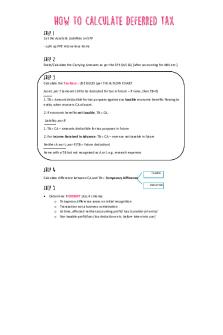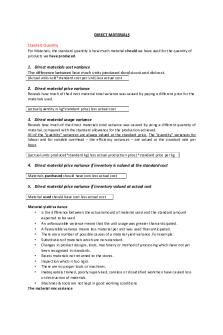How to Calculate Noon Sun Angles? PDF

| Title | How to Calculate Noon Sun Angles? |
|---|---|
| Author | angelica ackerson |
| Course | Environmental Geography |
| Institution | Chaffey College |
| Pages | 3 |
| File Size | 137.8 KB |
| File Type | |
| Total Downloads | 37 |
| Total Views | 141 |
Summary
step by step calculation of noon sun angles...
Description
Calculating Noon Sun Angle: When you are looking at the altitude of the sun in relation to the angle of the earth’s tilt, you begin to understand how and why we have seasons on this planet. Because the earth is tilted at 23.5 degrees, the sun’s energy is diffused over a greater surface area as the angle of the earth’s surfaces increases north or south from the Equator. As stated in your textbook, pg. 48, the only point receiving incoming solar radiation or ‘insolation’ perpendicular (at right angle, or straight overhead) to the surface of the earth is called the Subsolar Point. The Subsolar Point occurs moving north or south of the equator between 23.5 degrees north (Tropic of Cancer) and 23.5 degrees south (Tropic of Capricorn) and energy in these areas is more concentrated. All other locations north of the Tropic of Cancer or south of the Tropic of Capricorn therefore receive less energy at a greater angle. The more you increase the degrees of latitude, the greater this influence on seasonal variation. The Noon Sun Angle is one way to develop an understanding as to the angle of insolation making its way to the surface at any location. The sun can only go as far as straight overhead – once earth rotates past noon, the sun begins its decent in the sky. So, the maximum angle of the sun can only be 90 degrees, which is the Subsolar Point. Therefore, if you know the latitude of your location, and the Subsolar Point on a certain date, you can figure out the Noon Sun Angle. When you know that, you will see the reason why days are shorter or longer during the various seasons. This is an example of how to calculate the Noon Sun Angle. You are looking for the angle of the sun in the sky from where you are standing. Find: The Noon Sun Angle in San Diego (32º North Latitude) on October 20. Start with recognizing whether the location you are calculating for is north or south of the equator. You know from the problem that the given location is 32º North Latitude. Now, go to your Analemma.
The Analemma shows the path of the Subsolar Point throughout one calendar year. You will look to the outer edge of the Analemma for the Month. Then, find the exact day for the problem that you are given. Now, follow a straight line across to the center black-and-white measure line. That will give you the altitude in degrees of the sun on that date. You will notice that the Equator is not at the crossing of the figure 8 on the Analemma, but at the date of the Vernal and the Autumnal Equinox. If the Subsolar Point is north of the equator and your location is north of the equator, you will need to subtract one from another. If the Subsolar Point is south of the equator and your location is north of the equator, then you will add the two degrees. On October 20 the Subsolar Point is 10º South Latitude
So, make a drawing of the location, the line of the equator and the Subsolar Point (from your Analemma) on paper. This will enable you to decide whether the degrees are going to be added or subtracted. It’s a simple calculation to figure out what the Noon Sun Angle is at your location on that day.
This is your formula to calculate the Noon Sun Angle: 90- (Degrees of latitude of your location +/- Subsolar Point) = Noon Sun Angle The final equation that looks like this: 90 - (32+10) = 48 degrees In other words, the sun will only get 48 degrees high in the sky, so it must be autumn! The sun will rise later and set sooner, and the weather will be cooler. If the Subsolar Point is on the same side of the equator, your equation would look different: 90 - (32-10) = 68 degrees The Subsolar Point is now higher in the sky, and it is springtime. Also, on the analemma, remember to double check whether the Subsolar Point is North or South of the Equator in relation to your location. Remember: If the Subsolar Point is on the same side of the equator as the location, subtract. If the Subsolar Point is on the opposite side of the equator as the location, add....
Similar Free PDFs

How to Calculate Beta
- 2 Pages

How to Calculate Deferred Tax
- 3 Pages

How to Calculate your GPA
- 1 Pages

How to Calculate GST in a Flash
- 2 Pages
Popular Institutions
- Tinajero National High School - Annex
- Politeknik Caltex Riau
- Yokohama City University
- SGT University
- University of Al-Qadisiyah
- Divine Word College of Vigan
- Techniek College Rotterdam
- Universidade de Santiago
- Universiti Teknologi MARA Cawangan Johor Kampus Pasir Gudang
- Poltekkes Kemenkes Yogyakarta
- Baguio City National High School
- Colegio san marcos
- preparatoria uno
- Centro de Bachillerato Tecnológico Industrial y de Servicios No. 107
- Dalian Maritime University
- Quang Trung Secondary School
- Colegio Tecnológico en Informática
- Corporación Regional de Educación Superior
- Grupo CEDVA
- Dar Al Uloom University
- Centro de Estudios Preuniversitarios de la Universidad Nacional de Ingeniería
- 上智大学
- Aakash International School, Nuna Majara
- San Felipe Neri Catholic School
- Kang Chiao International School - New Taipei City
- Misamis Occidental National High School
- Institución Educativa Escuela Normal Juan Ladrilleros
- Kolehiyo ng Pantukan
- Batanes State College
- Instituto Continental
- Sekolah Menengah Kejuruan Kesehatan Kaltara (Tarakan)
- Colegio de La Inmaculada Concepcion - Cebu











